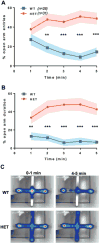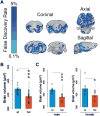Species-conserved SYNGAP1 phenotypes associated with neurodevelopmental disorders
- PMID: 29580901
- PMCID: PMC6128754
- DOI: 10.1016/j.mcn.2018.03.008
Species-conserved SYNGAP1 phenotypes associated with neurodevelopmental disorders
Abstract
SYNGAP1 loss-of-function variants are causally associated with intellectual disability, severe epilepsy, autism spectrum disorder and schizophrenia. While there are hundreds of genetic risk factors for neurodevelopmental disorders (NDDs), this gene is somewhat unique because of the frequency and penetrance of loss-of-function variants found in patients combined with the range of brain disorders associated with SYNGAP1 pathogenicity. These clinical findings indicate that SYNGAP1 regulates fundamental neurodevelopmental processes that are necessary for brain development. Here, we describe four phenotypic domains that are controlled by Syngap1 expression across vertebrate species. Two domains, the maturation of cognitive functions and maintenance of excitatory-inhibitory balance, are defined exclusively through a review of the current literature. Two additional domains are defined by integrating the current literature with new data indicating that SYNGAP1/Syngap1 regulates innate survival behaviors and brain structure. These four phenotypic domains are commonly disrupted in NDDs, suggesting that a deeper understanding of developmental Syngap1 functions will be generalizable to other NDDs of known or unknown etiology. Therefore, we discuss the known molecular and cellular functions of Syngap1 and consider how these functions may contribute to the emergence of disease-relevant phenotypes. Finally, we identify major unexplored areas of Syngap1 neurobiology and discuss how a deeper understanding of this gene may uncover general principles of NDD pathobiology.
Keywords: Autism spectrum disorder; Circuits; Cognitive impairment; Epilepsy; Intellectual disability; Microcephaly; Neurodevelopment; SynGAP; Synapse; Syngap1.
Copyright © 2018 Elsevier Inc. All rights reserved.
Figures




Similar articles
-
SYNGAP1 Controls the Maturation of Dendrites, Synaptic Function, and Network Activity in Developing Human Neurons.J Neurosci. 2020 Oct 7;40(41):7980-7994. doi: 10.1523/JNEUROSCI.1367-20.2020. Epub 2020 Sep 4. J Neurosci. 2020. PMID: 32887745 Free PMC article.
-
Phenotypic characterization of individuals with SYNGAP1 pathogenic variants reveals a potential correlation between posterior dominant rhythm and developmental progression.J Neurodev Disord. 2019 Aug 8;11(1):18. doi: 10.1186/s11689-019-9276-y. J Neurodev Disord. 2019. PMID: 31395010 Free PMC article.
-
SYNGAP1 mutations: Clinical, genetic, and pathophysiological features.Int J Dev Neurosci. 2019 Nov;78:65-76. doi: 10.1016/j.ijdevneu.2019.08.003. Epub 2019 Aug 24. Int J Dev Neurosci. 2019. PMID: 31454529 Review.
-
Multi-parametric analysis of 57 SYNGAP1 variants reveal impacts on GTPase signaling, localization, and protein stability.Am J Hum Genet. 2021 Jan 7;108(1):148-162. doi: 10.1016/j.ajhg.2020.11.011. Epub 2020 Dec 11. Am J Hum Genet. 2021. PMID: 33308442 Free PMC article.
-
SYNGAP1 Syndrome and the Brain Gene Registry.Genes (Basel). 2025 Mar 30;16(4):405. doi: 10.3390/genes16040405. Genes (Basel). 2025. PMID: 40282364 Free PMC article. Review.
Cited by
-
Comprehensive behavioral analysis of heterozygous Syngap1 knockout mice.Neuropsychopharmacol Rep. 2019 Sep;39(3):223-237. doi: 10.1002/npr2.12073. Epub 2019 Jul 19. Neuropsychopharmacol Rep. 2019. PMID: 31323176 Free PMC article.
-
Clinical opportunity awaits at the intersection of genomics and brain imaging.J Psychiatry Neurosci. 2022 Aug 10;47(4):E293-E298. doi: 10.1503/jpn.220075. Print 2022 Jul-Aug. J Psychiatry Neurosci. 2022. PMID: 35948342 Free PMC article. No abstract available.
-
Assessment of Autism Zebrafish Mutant Models Using a High-Throughput Larval Phenotyping Platform.Front Cell Dev Biol. 2020 Nov 23;8:586296. doi: 10.3389/fcell.2020.586296. eCollection 2020. Front Cell Dev Biol. 2020. PMID: 33330465 Free PMC article.
-
Analysis of Differentially Expressed Genes in the Dentate Gyrus and Anterior Cingulate Cortex in a Mouse Model of Depression.Biomed Res Int. 2021 Feb 11;2021:5013565. doi: 10.1155/2021/5013565. eCollection 2021. Biomed Res Int. 2021. PMID: 33628784 Free PMC article.
-
SYNGAP1 Controls the Maturation of Dendrites, Synaptic Function, and Network Activity in Developing Human Neurons.J Neurosci. 2020 Oct 7;40(41):7980-7994. doi: 10.1523/JNEUROSCI.1367-20.2020. Epub 2020 Sep 4. J Neurosci. 2020. PMID: 32887745 Free PMC article.
References
Publication types
MeSH terms
Substances
Grants and funding
LinkOut - more resources
Full Text Sources
Other Literature Sources

